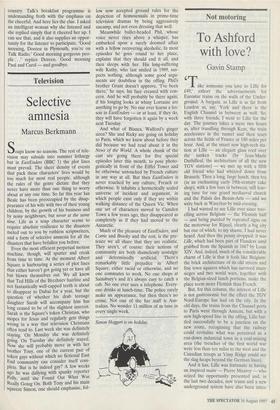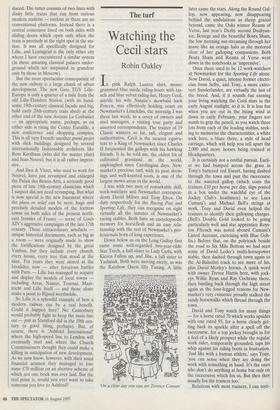Not motoring
To Ashford with love?
Gavin Stamp
Take someone you love to Lille for £49,' exhort the advertisements for Eurostar trains on the walls of the Under- ground. A bargain, as Lille is as far from London as, say, York and there is the English Channel in between as well. So, with three friends, I went to Lille for the day. The journey takes a mere two hours as, after trundling through Kent, the train accelerates in the tunnel and then tears across the fields of France at 180 miles per hour. And, at the smart new high-tech sta- tion at Lille — an elegant glass roof over the sunken tracks (by Jean-Marie Duthilleul, the architecture of all the new TGV stations) — we met up with a fifth old friend who had whizzed down from Brussels. Then a long, large lunch, then tea (in an enchanting early 19th-century cake shop), with a few bars in between, still leav- ing time for one grand mediaeval church and the Palais des Beaux-Arts — and we were back in Waterloo by mid-evening.
I had wanted to see Lille ever since trav- elling across Belgium — the Flemish half — and being puzzled by repeated signs on the motorway for Rijssel, clearly a big city but one of which, to my shame, I had never heard. And then the penny dropped: it was Lille, which had been part of Flanders until grabbed from the Spanish in 1667 by Louis XIV. And, indeed, much of the considerable charm of Lille is that it feels like Belgium: the brick architecture of its old streets and fine town squares which has survived many sieges and two world wars, together with the Belgian-sized lunch portions, make the place seem more Flemish than French.
But, for this column, the interest of Lille is not gastronomic but the effect the TGV Nord-Europe has had on the city. In the old days, the trains from the Channel ports to Paris went through Amiens, but with a new high-speed line in the offing, Lille bat- tled successfully to be a junction on the new route, recognising that the railway could revitalise what was perceived as a run-down industrial town in a coal-mining area (the trenches of the first world war were less than ten miles to the west and the Canadian troops at Vimy Ridge could see the slag-heaps beyond the German lines). And it has. Lille was fortunate in having an inspired maire — Pierre Mauroy — who seized the opportunity presented and, in the last two decades, new trams and a new underground system have also been intro- duced. The latter consists of two lines with dinky little trains that run from curious modem stations — curious as there are no conventional platforms. Instead there is a central concourse lined on both sides with sliding doors which open only when the train is precisely at the right spot in the sta- tion. It was all specifically designed for Lille, and Leningrad is the only other city where I have encountered a similar system (in those amazing classical palaces under- ground which are surpassed in grandeur only by those in Moscow).
But the most spectacular consequence of the new railway is a large chunk of urban development. The new Gare TGV Lille- Europe is only a quarter of a mile from the old Lille-Flandres Station (with its hand- some 19th-century classical façade and big, bold early 20th-century train shed) at the other end of the new Avenue Le Corbusier — an appropriate name, perhaps, as on either side is rising the Centre Euralille, a new conference and shopping complex. This is all very French: another grand projet with slick buildings designed by several internationally fashionable architects like Rem Koolhaas (who did the master plan) and Jean Nouvel, but it is all rather impres- sive.
And Ibos & Vitart, who used to work for Nouvel, have just revamped and enlarged the Palais des Beaux-Arts, a seriously good piece of late 19th-century classicism which I suspect did not need revamping. But what is now special is the new basement where the plans en relief can be seen: huge and precisely detailed models of the fortress towns on both sides of the present north- east frontier of France — scene of Louis XIV's aggressive campaigns of the late 17th century. These extraordinary artefacts unique historical documents, each as big as a room — were originally made to show the fortifications designed by the great Vauban, but they include every church, every house, every tree that stood at the time. For years they were stored at the Invalides; now — after ferocious battles with Paris — Lille has managed to acquire and display the models of local towns including Arras, Namur, Tournai, Maas- tricht and Lille itself — and those alone make a jaunt to Rijssel worthwhile.
So Lille is a splendid example of how a modem railway can be a real benefit. Could it happen here? No: Canterbury would probably fight to keep the main line out — just as Stamford did in the 19th cen- tury (a good thing, perhaps). But, of course, there is 'Ashford International' where the high-speed line to London will eventually start and where the Church Commissioners thought they could make a killing in anticipation of new development. As we now know, however, with their usual financial acumen they managed to lose some £70 million on an abortive scheme of which not one brick was ever laid. But the real point is, would you ever want to take someone you love to Ashford?



























































 Previous page
Previous page